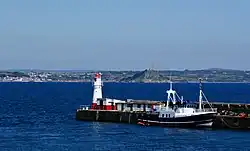Ordnance datum
An ordnance datum or OD is a vertical datum used by an ordnance survey as the basis for deriving altitudes on maps. A spot height may be expressed as AOD for "above ordnance datum". Usually mean sea level (MSL) at a particular place is used for the datum. In particular:
- In Great Britain, OD for the Ordnance Survey is ODN (Ordnance Datum Newlyn), defined as the MSL as recorded by the Newlyn Tidal Observatory between 1915 and 1921.[1]
- Prior to 1921, OD was defined as MSL as recorded in the Victoria Dock, Liverpool, during a short period in 1844 (ODL).
- In Northern Ireland, OD for the Ordnance Survey of Northern Ireland is Belfast Ordnance Datum, the MSL at Clarendon Dock, Belfast, between 1951 and 1956.
- In Ireland, OD for the Ordnance Survey of Ireland is Malin Ordnance Datum: the MSL at Portmoor Pier, Malin Head, County Donegal, between 1960 and 1969.[2]
- Prior to 1970, Poolbeg Ordnance Datum was used: the low water of spring tide at Poolbeg Lighthouse, Dublin, on 8 April 1837. Poolbeg OD was about 2.7 metres (9 feet) lower than Malin OD.[2]


Ordnance Datum Newlyn and its antecedents
The First Geodetic Levelling of England and Wales (1840–1860) needed to define a datum plane from which to specify spot heights. At first it was specified as a horizontal plane 100 feet below an arbitrary benchmark on St John's Church, Liverpool. Subsequently, however, it was redefined as mean sea level (MSL). To establish MSL, tidal observations were taken at the Victoria Dock, Liverpool, over a short period in 1844.
By the time of the Second Geodetic Levelling (1912–1921) the importance of stability was better appreciated and so it was decided to use Fundamental Bench Marks (FBMs) installed in solid rock, rather than on buildings as before. To measure average MSL around Great Britain three tide gauges were employed: at Dunbar, Newlyn and Felixstowe. However, it was found that the measured difference between the Dunbar and Newlyn stations was 0.81 feet (0.247m), far larger than could be accounted for by error. The difference was real. Accordingly, it was decided not to use average MSL and fix on one site: MSL Newlyn. Newlyn has certain practical advantages: it is set in granite bedrock, is far from major rivers, and it better represents deep ocean sea levels.
The difference between ODL (Liverpool) and ODN (Newlyn) was found to be 0.13 feet. It took some time for the changed definition — Liverpool to Newlyn — to work through the system: by 1950, some 40% of the lower secondary and tertiary levellings were still using the Liverpool datum. But following the Third Geodetic Levelling, Ordnance Survey maps published since March 1956 give spot heights above the Newlyn datum.[3][4]
Newlyn Tidal Observatory was given grade II listing on 11 December 2018.[5]
Tunnel datum
Tunnel datum is a datum based on an ordnance datum and used in designing tunnels which pass below sea level.
- for the London Underground, a tunnel datum of ODN −100 m is used;[6] thus a depth of −60 m AOD is 40 m ATD (above tunnel datum)
- for the Channel Tunnel, a tunnel datum of ODN −200 m is used;[7] thus a depth of −60 m is 140 m ATD
See also
- Ordnance Survey National Grid – System of geographic grid references used in Great Britain
- Principal Triangulation of Great Britain – 1791–1853 geodetic survey of Britain
- Chart datum – Level of water from which depths displayed on a nautical chart are measured
- Trinity High Water – Official authority for lighthouses in England
- Vertical Offshore Reference Frames – UK and Irish hydrographic vertical datum
References
- "Ordnance Survey Benchmark locator". Archived from the original on 27 December 2021. Retrieved 21 December 2021.
- Irish Grid Reference System Archived 2008-06-14 at the Wayback Machine from OSI website
- Bradshaw, et al. (2016). "A Century of Sea Level Measurements at Newlyn, Southwest England". Marine Geodesy. 39 (2): 115–140. doi:10.1080/01490419.2015.1121175.
- "Ordnance Survey Benchmark locator". Archived from the original on 27 December 2021. Retrieved 21 December 2021.
- "Newlyn tidal observatory and part of the south pier". English Heritage. Retrieved 17 October 2023.
- "Victoria Station Upgrade Environmental Statement: Main Report" (PDF). Transport for London. 15 November 2007. pp. 2–6, §2.5.4, fn 2. Archived (PDF) from the original on 4 June 2011. Retrieved 28 July 2008.
- Radcliffe, Eric (1995). "Control and Construction Surveys". In Colin J Kirkland (ed.). Engineering the Channel Tunnel. Taylor & Francis. p. 53. ISBN 0-419-17920-8.